|

|
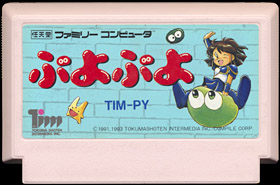
|
|
ぷよぷよ
©1991,1993 Tokuma Shoten Intermedia Inc.
Compile Corp.
Release: 1993-07-22 (¥5900)
Cartridge TIM-PY
Puzzle game
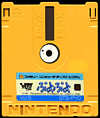

|
Released in Japan (Disk Writer) as PUYO PUYO
( GTS-PYO )
1991-10-25
|
|
Puyo Puyo doesn't need much of an introduction - the now classic puzzle
game was first released for the Japanese MSX and Famicom in 1991,
and although this early version uses only a fraction of what made the franchise
so successful, it boasts the same fundamental gameplay mechanics. The game borrows
primarily from the classic Tetris and the main objective is fairly simple
and straightforward - pairs of colored Puyos (small slimy creatures in the
form of jelly beans) fall from the top of the screen, and the player must combine
then in groups of four (or more) to make them disappear. Once they do, all the
Puyos located directly above the newly created gap fall downwards, thus
creating new groups and potentially triggering more chain reactions for extra
points. This version of Puyo Puyo offers two main play modes - the first
one, called 'Endless', offers an unlimited flow of Puyos and no
time limit. The second mode, called 'Mission', requires the player to
complete fifty two discrete levels and to fulfil certain conditions or predefined
goals, such as completing chains, cleaning a given amount of puyos or
to only clear puyos of a specific color. Additionally, this version also
includes a versus mode allowing two players to compete against each other. In
this competitive mode, linking chains and combos bombards the opponent's
playfield with garbage puyos, black/transparent beans that fill the
player's area, and the only way to remove these perky nuisances is to quickly
form combos next to them.
Finally, this version of Puyo Puyo offers a myriad of options to
customize the game to any liking, from difficulty level, background music,
sound effects to special items and even the shape of the Puyos
(they can be turned into Humans! see the info section below for
more information about this unforeseen option).
|
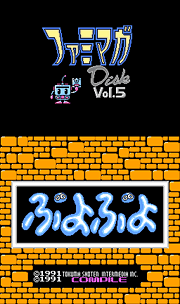 Although the Famicom cartridge edition of Puyo Puyo (version tested here)
was released in 1993, the original Famicom Disk System game was released two years
earlier, on October 25th 1991 (same release date as the MSX version it seems).
The disk version was published by Tokuma Shoten Intermedia as part of their
Family Computer Magazine series ("Famimaga" for short). Apparently, five
games were released through the Famimaga series - Hong Kong (Vol.1),
Panic Space (Vol.2), All One (Vol.3), Clox (Vol.4) and
Puyo Puyo (Vol.5). Like most of the Famimaga games, Puyo Puyo
didn't come with any box and therefore doesn't have any known box-art. The cartridge
(version tested here) and the Famicom Disk versions show some differences - the
introduction screen was obviously altered and references to Famimaga were removed
(the game's title looks slightly different as well),
but most importantly, the Mission mode now uses passwords whereas the player's
progress could directly be saved onto the Famicom Disk in the original edition.
Although the Famicom cartridge edition of Puyo Puyo (version tested here)
was released in 1993, the original Famicom Disk System game was released two years
earlier, on October 25th 1991 (same release date as the MSX version it seems).
The disk version was published by Tokuma Shoten Intermedia as part of their
Family Computer Magazine series ("Famimaga" for short). Apparently, five
games were released through the Famimaga series - Hong Kong (Vol.1),
Panic Space (Vol.2), All One (Vol.3), Clox (Vol.4) and
Puyo Puyo (Vol.5). Like most of the Famimaga games, Puyo Puyo
didn't come with any box and therefore doesn't have any known box-art. The cartridge
(version tested here) and the Famicom Disk versions show some differences - the
introduction screen was obviously altered and references to Famimaga were removed
(the game's title looks slightly different as well),
but most importantly, the Mission mode now uses passwords whereas the player's
progress could directly be saved onto the Famicom Disk in the original edition.
|
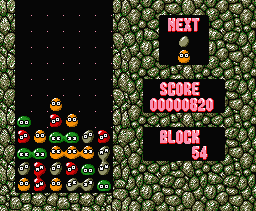 The original Puyo Puyo was released on October 25th 1991 for the MSX
computer (picture on the left) and the Famicom Disk System. Interestingly, Kazunari Yonemitsu,
the original designer of Puyo Puyo and founder of the video game company
Sting Entertainment, mentioned that the game was originally based on an
abandoned puzzle title, apparently destined to be released for Compile's
MSX Disk Station series. Yonemitsu picked up work on the project
in his own time - after experimenting with the gameplay, he started working on the
graphics. His idea was to use 'soft' characters, to contrast with Tetris's
perfect blocks, and his initial intent was to use human figures.... and although
the concept was eventually dropped, it can still be seen in the Famicom
version of the game! But why create something new when you have everything you need
within arm's reach ? Yonemitsu decided to borrow the cutesy characters
from Madō Monogatari, a first-person dungeon crawler RPG
(featuring a little girl called Arle and her odd chum Carbuncle)
he helped develop at Compile and originally released in 1989. And this is
how the eponymous jelly characters entered the franchise. Although the game was
destined for great things, the first release was not a significant commercial
success... So Compile and Sega decided to unite forces and to
expand the original game - the cute Arle Nadja became the heroine of
the game and a nonsensical story mode was created to chronicle her adventures.
But most and foremost, an extensive cast of colorful and often absurd characters
was were added to the mix, allowing players to enjoy solo plays like never
before. Finally, the 'Missions' from the original game were completely
removed (however, they will be later revived as a spin-off series called
Nazo Puyo). The new Puyo Puyo was finally released as
an arcade game in 1992 and became a smashing hit! See Puyo Puyo
for the PC Engine system for more information about the
Puyo Puyo series.
The original Puyo Puyo was released on October 25th 1991 for the MSX
computer (picture on the left) and the Famicom Disk System. Interestingly, Kazunari Yonemitsu,
the original designer of Puyo Puyo and founder of the video game company
Sting Entertainment, mentioned that the game was originally based on an
abandoned puzzle title, apparently destined to be released for Compile's
MSX Disk Station series. Yonemitsu picked up work on the project
in his own time - after experimenting with the gameplay, he started working on the
graphics. His idea was to use 'soft' characters, to contrast with Tetris's
perfect blocks, and his initial intent was to use human figures.... and although
the concept was eventually dropped, it can still be seen in the Famicom
version of the game! But why create something new when you have everything you need
within arm's reach ? Yonemitsu decided to borrow the cutesy characters
from Madō Monogatari, a first-person dungeon crawler RPG
(featuring a little girl called Arle and her odd chum Carbuncle)
he helped develop at Compile and originally released in 1989. And this is
how the eponymous jelly characters entered the franchise. Although the game was
destined for great things, the first release was not a significant commercial
success... So Compile and Sega decided to unite forces and to
expand the original game - the cute Arle Nadja became the heroine of
the game and a nonsensical story mode was created to chronicle her adventures.
But most and foremost, an extensive cast of colorful and often absurd characters
was were added to the mix, allowing players to enjoy solo plays like never
before. Finally, the 'Missions' from the original game were completely
removed (however, they will be later revived as a spin-off series called
Nazo Puyo). The new Puyo Puyo was finally released as
an arcade game in 1992 and became a smashing hit! See Puyo Puyo
for the PC Engine system for more information about the
Puyo Puyo series.
|
O
M
A
K
E
|
|
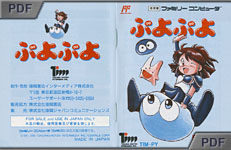
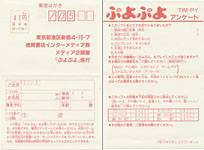
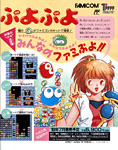
|
|
|
Click on picture to enlarge |
|
|
|
LK

|
|
Add your Pov here !
|
P
O
V
s
|
|
Being the first and original version of Puyo Puyo, this port is
indeed fairly basic - no AI opponents, no story mode and therefore, no
characters such as Arle on screen (Carbuncle does a small
appearance as a bonus item though). However, this early version is the first
Puyo Puyo game ever released by Compile, before the joint
venture with Sega and concequently, before it became a wildly successful
arcade game and a very profitable franchise. And I am so glad this version exists!
It gives us a rare insight into the origins of this enduring classic. It is
truly fascinating to discover this early version of Puyo Puyo, and how
much the basic foundation of its gameplay and the mainspring of its success
were already in place. But Puyo Puyo fans should think twice before
picking this one up, the game is a bare-bone version with minimal
features - well, that being said, although the 'Endless' mode
quickly becomes a tiring exercise (and it is really challenging!), the missions (as long as you
can read japanese a little) and the two-player battle mode do really
breathe extended life into this game. All in all, although this version
is very basic, it is still really fun to play and it is a valuable
piece of Puyo Puyo history.
|
|
|
|